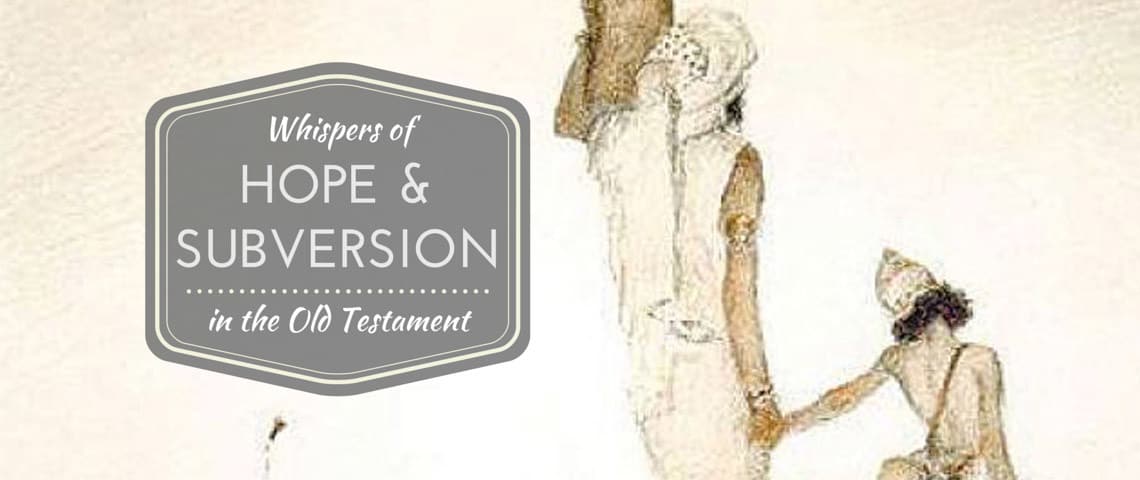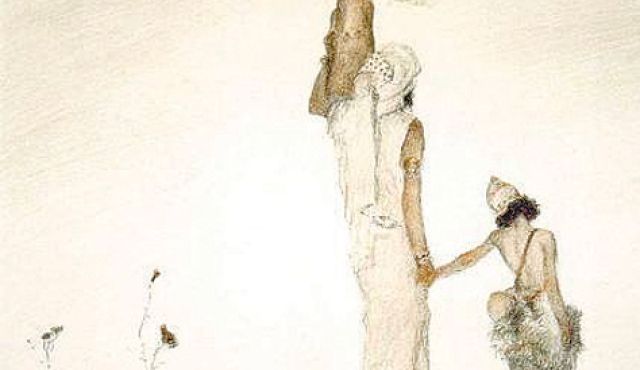Recently Megan Pritchett shared four observations after interviewing women about faith, feminism and identity.
In her last point Megan wrote this:
For almost all of the women I’ve talked with who strongly believe in egalitarianism and a feminist hermeneutic, there was some tipping point in their lives that made them reconsider their understandings.
My tipping point involved a change in how I interpreted and understood the Bible, in how I encountered God through Scripture as a woman.
My views were challenged when ministry opportunities in my complementarian church intersected with my seminary studies. The more ministry experience I gained, the more I found myself dreaming of doing things on the other side of the gender barrier like teaching and preaching. I wanted to believe that God’s purposes for women included occupying spaces men had reserved for themselves. But I needed my belief to be grounded in something more than my own dreams or a cultural trend.
The shift started with my first class “Biblical Perspectives of Women”, taught by a professor who kept her personal views to herself and allowed the students to figure out their own. We studied biblical passages and books like Women in Ministry: Four Views that offered arguments on both sides of the issue. But the class only frustrated me as each side, in my mind, offered equally convincing arguments. It was like the crazy debate over #TheDress with people seeing the same picture and coming up with opposite interpretations, one insisting the dress was “blue and black” while the other saw “white and gold.”
I kept waiting for someone to produce the real “dress”; to discover conclusive evidence that one could not apply a “plain” reading to the problem passages for women. I waited for someone to nail the “ninety five theses” to a door and cause a reformation for women similar to what Luther did for the doctrine of grace. (Okay, I know that’s a bit dramatic.)
It was discouraging to have only two options available to me — either an outright rejection of the authority of Scripture or a stubborn but inconsistent application of a simplistic, literal reading of the text.
I kept hoping the patriarchal world of God’s Word had something to say to me other than silence and submission and smallness.
As I began my Hebrew and Old Testament studies, the text became more nuanced and layered. Understanding Hebrew literary technique opened up a new world of exegesis and interpretation. It also confronted and challenged my past training in biblical studies that was inadequate to deal with the violent and dehumanizing treatment of women in the Old Testament [1].
To move in this ancient world I had to develop new ways of seeing and discerning God in the midst of troubling and sometimes contradictory texts. I developed what Jacqueline E. Lapsley calls a “hermeneutic of informed trust.”[2] As a believer committed to the full authority of Scripture, such a hermeneutic has allowed me to encounter God in Scripture no matter what the text says on the surface, no matter how disturbing the description of women’s experiences.
I choose to proceed with one main assumption: that I can trust the God of love and justice to offer “whispers” of hope for women despite the broken, sinful culture from which the text speaks.
With this hermeneutic, the Old Testament has become a world of subtlety and subversion, of mystery and beauty, of affirmation and empowerment.
I remember the first time I heard someone offer a whisper of subversion from the text. It came from Carolyn Custis James when she came to the seminary to present her book When Life and Beliefs Collide. I finally heard what I had been waiting for—an application of sound biblical exegesis to the phrase ezer kenegdo. Often translated as “suitable helper”, this phrase in Genesis 2:18 is one of the oldest sources of diminishment for women. Citing the original Hebrew meaning of the words and noting other instances where ezer is used in the Old Testament, James offered another translation; strong warrior. [3]
“Suitable helpmeet” transformed into “strong warrior.” With this empowering title what woman would want to go back to second-class human?
Not me. And James made that possible by putting a megaphone to a beautiful whisper in Scripture. It may seem strange that I became an egalitarian through the back door of Old Testament patriarchal culture and history. But it worked for me because the whispers of subversion became louder than the voices of patriarchy and oppression. Those whispers sounded like God. My Old Testament studies gave me permission to rethink the New Testament and how its writings might also be subversive to patriarchy. Eventually I followed those whispers into the egalitarian camp. I was all in.
The hermeneutic of informed trust was the tipping point for me.
Since that time I have witnessed an explosion of academic and pastoral books framing the lives of women in the Bible in new and empowering ways. I especially appreciate the books that dig deep to reveal subversion within the text, whether the author was aware of it or not. It’s one thing to analyze the stories of women and then recast their character and contribution to the biblical narrative in a more positive and sympathetic light through the eyes of a female reader. It’s another thing to detect an underlying resistance to patriarchy through the storytelling or poetry of a male author who lived within the patriarchal culture he was subverting.
Sarah and Hagar: The Center of Abraham’s Story
Frymer-Kensky gives another example of a whisper of subversion in her analysis of the story of Abraham and Sarah found in Genesis 12-22. [4] The chapters are laid out in a “chiasm,” a common Hebrew literary structure.
Western thought tends to move in a linear fashion; stories move from an introduction to a conflict and end with the climax and resolution. The trip has a one-way direction. A chiasm has a different progression. The trip is a two-way one – the journey in also has a journey out. The turning point identifies the main point or central story. You can tell you have a chiasm because there are repeating elements (words, phrases or themes) surrounding the central point. [5]
This is how the chiasm of Genesis 12-22 is laid out:
“Go to the land I will show you!” Abraham has to let go of family ties (Gen. 12:1-9)
The Lie to Pharaoh: “Sarah is my sister”(Gen. 12:10-20)
Lot chooses Sodom and has to be rescued by Abraham (Gen. 13-14)
The Covenant Sign: torches and carcasses (Gen. 15)
Sarah and Hagar (Gen. 16)
The Covenant Sign: circumcision (Gen. 17)
Lot has to be rescued from the destruction of Sodom (Gen. 18-19)
The Lie to Abimelech: “Sarah is my sister” (Gen. 20)
“Go to the mountain I will show you!” Abraham has to let go his son, Isaac (Gen. 22)
The chiasm reveals that the central story concerns Sarah and Hagar.
With the help of the biblical author we find a structural layout that whispers subversion under the surface of the dominant patriarchal perspective. By focusing the spotlight on the women in this way, God the Divine Inspirer of Scripture resists man’s efforts to be the center of God’s story.
I believe God has never really ignored the plight of women but has been subverting patriarchy since the fall of humankind.
More whispers have been found and others have yet to be discovered. I am hopeful that over time these whispers will combine into one unified shout for the end of patriarchy and the reformation of the church into a community of mutual partnership and ministry.
———————————–
NOTES
[1] Judges 19 is one example of this dehumanization in the Old Testament.
[2] In Whispering the Word Jacqueline E. Lapsley, associate professor of Old Testament at Princeton Theological Seminary, defines the “hermeneutic of informed trust” as being informed by history, tradition and experience. Such a hermeneutic “frees us to encounter God in Scripture—frees us to expect that God is telling us something significant, even revelatory, about ourselves, about who God is, and about our life together.” (p. 19)
[3] James develops this game-changing understanding of Eve and women in the book, Half the Church: Recapturing God’s Global Vision for Women. Read an excerpt here.
[4] See Tikva Frymer-Kensky. Reading the Women of the Bible: A New Interpretation of Their Stories.
[5] Click here for another example of the use of chiastic structure in the Bible.
Image credit: “Hagar and Ishmael” by Abel Pann (1950)





29 Comments
Harriet, I had no idea of the chiasm, that is so powerful. We read that God told Abraham to listen to his wife, and in many contexts it’s put in a ‘put up with her nagging, anything to keep her happy’ context, and yet that is not what the story tells us.
This is a powerful refutation of patriarchal rightness and really helpful to my own writings. Thanks.
Glad this was helpful, Bev. I agree that the characterization of Abraham is a bit off. In fact I have a feeling that if we were to take a really close look at the leading men of the OT they won’t fit neatly in the patriarchal stereotypes we have created.
Carolyn’s work and my singleness were the tipping points for me. Thank you for your great thoughts.
http://everybitterthingissweet.com/2012/05/the-calling-for-those-who-wait/
Have you read “Guardian Angel” by Skip Moen? If you haven’t I think you would be greatly encouraged by it.
http://skipmoen.com/books/guardian-angel.pdf
No I haven’t. Thanks!
I’d love to hear your thoughts when you are done reading it.
Sisters!!!! We share the same heartbeat!!! And, I know, it is so connected to the very heartbeat of God. This is why women are NEEDED in all levels of theological discussion. God is still healing me from all the spiritual abuse I endured as a young girl from an institutionalized patriarcal church culture. For YEARS I couldn’t read huge portions of the Bible. It was too painful. I struggled in my relationship with God because I couldn’t understand why He loved me less. I couldn’t understand why He didn’t care about the plight of women. I now understand that the destructive teaching I received as an emerging young woman wasn’t from God. It was never His heart for me. God would never skip over things like polygamy, sexual abuse, injustice, and inequality as well as a plethora of other serious issues. He wouldn’t rush through them to arrive to some hero. Women understand the depth of destruction done to the female psyche when we feel like God doesn’t care. We see the Holy Scriptures differently than men, not more clearly, just differently. We experience the Biblical accounts with great intensity and sometimes great angst. We hear the voice of God in a way that needs to be proclaimed to a hurting world. I hear His whispers telling me that He loves me and values me the same as He does any of His sons. Thank you Junia Project for being part of my healing!
Thank you, Leah, for sharing your story and so glad you are listening to God’s whispers of love!
Oh, I just loved this piece! It echoed my own journey in many ways. My “tipping point” was studying the women of the OT and NT as well. I just kept thinking, “No. There are just too many exceptions of female leaders for patriarchy to be the intended rule. Either this is the way God wanted it to be or he is too impotent to get it right.”
Tikva Frymer-Kensky’s book was super transformative for me as well, which is interesting considering that she is Jewish and doesn’t write with Jesus as the Messiah as her foundation. There is a line in that book somewhere where she says essentially that the accounts of Old Testament women are showing Israel’s need for a king… but then the king himself wasn’t even enough. I literally stood up from my chair and let out a big WHOOP. YES! And then… Jesus. Frymer-Kensky missed that piece of the puzzle (heartbreaking). However, as a scholar who doesn’t know Christ herself, she could still see so clearly that the stories of OT women are begging for the Messiah. For me, realizing that God’s purposes of highlighting atrocities against women in the OT were precisely to shock and horrify because that is NOT what He wants for his daughters changed everything. This isn’t God standing by waiting for his leading men to get it right. This is God weeping over the mess we’ve made of his daughters and moving heaven and earth to make it right again. I want to be a part of that redemption in my small way.
Great post!
“This is God weeping over the mess we’ve made of his daughters and moving heaven and earth to make it right again.” Love this!
A “hermeneutic of informed trust”. I haven’t heard that phrase before, but I love it. It’s so much better than – perhaps the polar opposite of – a “hermeneutic of suspicion” which is used by Elisabeth Schüssler Fiorenza and a few other scholars.
Yes, I agree it is better! Lapsley specifically mentions the “hermeneutic of suspicion” as one she does not and cannot adopt because of what she believes about God. She says this about suspicion: “This posture has done little to ameliorate the church’s confused and alienated attitude toward the Old Testament. Ellen Davis rightly laments the church’s loss of intimacy and ‘friendship’ with the Old Testament, and urges a renewal of that friendship.”
Great piece, Harriet!
I wonder how you reconcile Leviticus 27:3-7. Honestly, whenever doubt about my faith creeps into my head it’s always centered around this passage where God puts a monetary value on life, and women are valued considerably less then men. I have such a hard time reading that and seeing that God, in essence, started this devaluation of women that was even more thoroughly perverted as time and history progressed.
I love how you were able to point out something I had never seen in the subverting of patriarchy with this piece and I was just curious how you dealt with this particular issue.
No doubt there are passages in the OT that make me scratch my head and wonder why God said what he did (like here) or why he didn’t say what he could have (like “I want you to have one wife at a time.”) I wrestle with the tension of my trust in a God who says women are valued equally with men and a God who enters into our culture without overturning its practices immediately. I don’t believe God is condoning our practices (like polygamy or slavery) but he allows it as he continues to work through his people and in history in progressive revelation until we see him in his son, Jesus. Once we see Jesus we can look back and look for God in new ways, and as I said here, subversive ways. I have learned to embrace OT ambiguity and messiness because it forces me to seek and trust God and wait for His voice to come through as I wrestle through troublesome passages.
In the case of Lev. 27, my initial research leads me to conclude this may be an example of this tension and perhaps more about religious practicality than a statement of personal worth. Apparently there has been considerable debate as to this chapter which is a weird ending to Leviticus. Some think it’s intended to be an appendix. Anyway the votive offering of 27:1-8 was a sum of money given to the temple to release a person who has made a vow to dedicate themselves to the service of God, sort of like becoming an assistant to the priest. One could also dedicate someone else as Hannah did with Samuel. The “equivalent value” (Hebrew word basically means “assessed value”) was probably a fair market value based on economic productivity or in this case religious productivity lost because the person was being released from service in the temple. The OT reality was that men were worth more economically than women, or children or elderly, unfortunate but understandable in the culture of that day. (Today I would accept the reality that my wage will be considerably less than a doctor’s or lawyer’s without feeling that my personal worth is affected.) One last thing. The amounts listed are ridiculously large considering the average wage was about one shekel per month. Most believe this was to discourage people from making rash vows they would not keep.
Perhaps there is another way to look at this passage and someone else has another understanding of it which I welcome you to share here. I hope at least your irritation is lessened.
Peace to you!
This had been a frustrating portion of Scripture for me as well until someone mentioned that in many Middle Eastern cultures at that time, a woman would’ve been worth NOTHING and yet she has worth here in Leviticus so the emphasis shouldn’t be that she’s worth less than a man but rather that she does have value and is worth something.
The one that still bothers me though is why a young woman who was raped had to marry the man who raped her. *sigh*
But I have to look at the overall picture my Creator has painted and see the beauty, mercy, justice, and love portrayed throughout it all and trust I might not understand all the how’s and why’s.
I’m glad to know I’m not alone in my struggles! Thanks for a beautiful post. I’ve never heard of a chiasm before and would love to learn more. Isn’t it great how there’s more and more depth in God’s word every time we look at it?
I don’t know if this is helpful, but in my work overseas I’ve begun to be able to see the compassion in that seemingly awful command is God’ supreme mercy. In some cultures, and I think ancient Hebrew culture, virginity is so valued that a girl without it (regardless of why) is simply left destitute. She is not marry-able.
Since women were only valued by their ability to produce male children, a woman who was not marriage material would have to become a beggar or a prostitute. So I see this command as God’s mercy working within a patriarchal system. He is essentially saying, “You raped her; you are obligated to care for her. And not just as a concubine. No, you must MARRY her and treat her with the honor of a wife – AND the mother of your heirs.” That is actually a powerful grace for these women. Instead of being left without hope because of their rape, God elevates them as far as possible within their own culture to status of honored wife. If God had simply demanded that the rapist be killed, the woman would still be left with no one to care for her.
I think it is hard for us to wrap our heads around because our culture marries based on love and personal choice. But for ancient Israel, few married for love or by choice. Marriages were arrangements. In some ways, marital sex was always (at least initially) a kind of “rape” because a girl didn’t choose to marry and couldn’t turn down the advances of her husband. The kind of relationship that we see as godly – mutual submission and love and respect, was probably extremely rare.
As far as that commandment, I think it was God making sure 1) she was provided for, 2) she didn’t bare the (unfair) shame of a defiled woman in society, and 3) her children would actually be given the inheritance of her rapist It’s weird, but I think if you dig more into it (the book referenced in this article talks about a lot of this stuff), you can see incredible grace and mercy at work.
Thank you for explaining that Dalaina. That is so helpful and a good reminder that we have to consider the context rather than interpret things according to our modern day understanding.
Yes, thank you! This is the beauty of having a forum where we have access to voices that are aware of other perspectives whether gendered or cultural and have insights that help us unpack the Bible. I loved your explanation!
Thank you so much for your cross-cultural (and cross-century) enlightenment. I have some, limited understanding of the absolute imperative of virginity for women. It was (sometimes, is still) often a necessity for men to know that the child their wife was pregnant with was, indeed, a product of their seed.
IMO, it would be culturally arrogant to take modern day morality/understanding and overlay it over centuries. And, transcending cultures, too. I totally agree with you in that God may very well be elevating women to the accepted/honored status of “wife,” instead of forcing them (totally against their will) to being outcasts.
Hey, thanks for an explanation that makes sense, fits in with a Biblical worldview, and lifts up the role of God as our protector,! I was puzzling over this very subject this morning. I like how the Lord often answers questions I have sometimes years down the line. We have to take what we absolutely know about God (He is love! He is mercy! He is judgement!) and hold it up to what we don’t exactly know or understand (Did God really ask Israel to wipe out an entire people group? Why did God allow a man to take two wives instead of just saying, um, no…take one. And, of course, did Adam and Eve have belly buttons?) and walk the beautiful and delicate line of of faith. I’m very thankful to have discovered this blog a few months ago!
Just thought I’d pipe in on the victim having to marry her rapist thing. If you research actual historical Jewish practice on this law, you will find that she didn’t actually have to marry her rapist. It was an option. Regardless of whether or not she took that route, she would still receive the bridal price from the rapist, if my memory serves correctly. If she did choose to marry him, you will note that in the law he cannot ever divorce her for any reason. Thus, under that generous condition, that left her free to NOT give him conjugal rights (he had none), cook his dinner, live in the same house, etc. In other words, the traditional Talmudic interpretation, as I have read from Jews, is that she can sit on the couch eating Bon-Bons all day and there was nothing he could do about it. He’d have to support her the rest of her life. It’s basically glorified alimony payments. He has no rights, but she has all the rights. She is financially set for life.
I hope that helps
That’s a great explanation! Thanks so much!
I was especially moved by these words: “It may seem strange that I became an egalitarian through the back door of Old Testament patriarchal culture and history. But it worked for me because the whispers of subversion became louder than the voices of patriarchy and oppression. Those whispers sounded like God.”
Thank you so much for tracing your path from a complementarian to egalitarian view of women in ministry. I have been thinking about this lately, myself. Ordinarily, I don’t think much about it. I am a commissioned member of the Federation of Christian Ministries, with an M.Div. and having served as a chaplain for most of the past ten years in Chicago. But thirty years ago, when I was studying church music at Moody Bible Institute (a thoroughly complementarian institution), the door to egalitarian ministry was just cracking open . . . only to be slammed shut once more with the resurgence of the Religious Right, James Dobson, and a whole host of other shrill voices putting women “in their place.”
Yes, I don’t ordinarily think of those things. I am busy _doing_. Listening, caring, ministering, praying, being the best and most effective lover of those God brings to me. I follow the whispers of God, like you. Your words remind me of the sermon I preached two days ago: Listen for the Shepherd’s Voice: Easter 4 #pastorpreacherprayer @StLukesChurch2 http://wp.me/p5Nfg4-G
I was just chatting with an old friend about our days at MBI in the early 1990s. Some good memories…but much to recover from as well. Glad you have found and are pursuing God’s calling and using the gifts he gave you!
Eliza, thank you for your words of encouragement. And your sermon is so true. Ultimately we are responsible to listen to Jesus’ voice and move forward in obedience even if there are voices that would question our calling, especially as women. I am so glad you persevered through that very difficult period of your studies. May God continue to richly bless your ministry as you follow His voice.
“My Old Testament studies gave me permission to rethink the New Testament…”
I love the way you phrased this. I have seen many people on a journey where having “permission” to rethink – or in many cases think for ourselves for the very first time – has unlocked the truth of scripture from the fetters of tradtion. Thanks for sharing!
Laura, you picked up on a major shift that happened for me as I revisited my NT studies after years of studying OT language and literary structure. A couple of thoughts hit me hard. The light bulb went on one day when I realized the NT was written for the most part by Jewish men! Which meant perhaps the NT contained elements of OT literary technique. This impacted my study of Ephesians 5 (I saw chiastic structure – see http://storyinthemiddle.blogspot.com/2012/06/deconstructing-marriage-metaphor-of.html).
The second thought had to do with how Israel in the OT had to constantly evolve in their understanding of God and how they should live. For example they had to deconstruct their history as a monarchy after the Babylonian exile. From that the book of Chronicles was written exposing a shift in their theology. It occurred to me that the NT history of the church is no different. The theology and practices of the church kept shifting even within the NT. What makes us think the words of Paul were intended to be set in stone forever? I concluded God is still transforming the church to be closer to his heart and intention for us. God is still doing new things. I wrote about this a couple of years ago in a post on Junia Project (https://juniaproject.com/between-eden-and-eternity/).
Sorry for this long reply but there was so much more I wanted to say in my post. You opened a crack and I couldn’t help but step through. 🙂
Thanks for your comment!
Life is usually best lived when we are willing to explore the cracks! Thanks for your insight (and more reading material for the evening!)
I should clarify that Paul’s teaching is gospel teaching and sound doctrine. What is not set in stone are his culturally defined statements especially about women. He challenges much of the patriarchy in household codes while at the same time preserving many practices for the sake of the gospel. But that doesn’t mean they hold when the culture changes, i.e. wearing braids, gold and pearls or women teaching (1 Tim. 2).